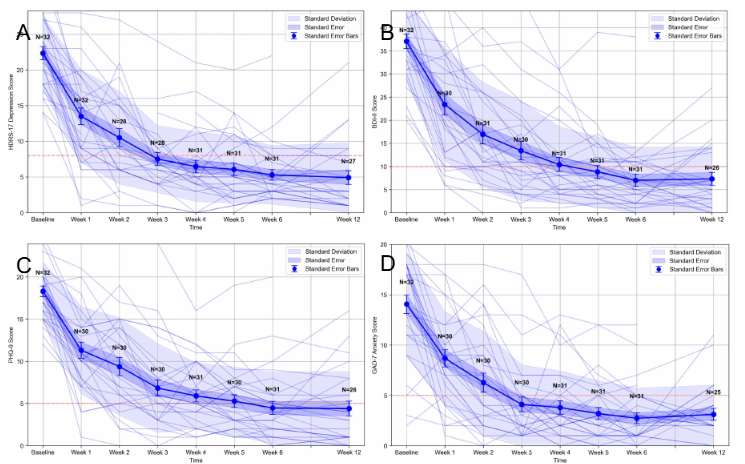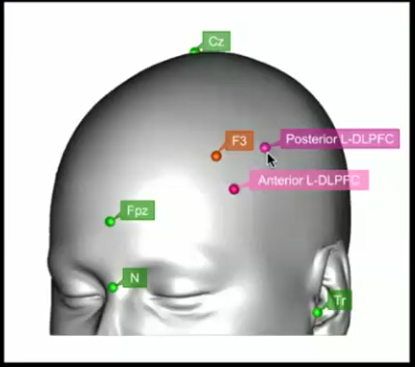TMS Articles
Learn more about different aspects of accelerated fMRI-guided TMS. See if treatment can help you live the life you want to live.
If depression keeps holding you back, you’re not alone—and you’re not out of options. Our non-invasive treatment uses advanced brain imaging to guide a highly targeted form of TMS therapy. The result? A faster and more effective path to feeling like yourself again.


Accelerated Full Course: ONE-D delivers a patient's entire course of Transcranial Magnetic Stimulation (TMS) therapy—conventionally requiring weeks of visits—in a single day, typically over a 10-hour period.
Intensive, Spaced Sessions: The single-day treatment involves 20 sessions of high-intensity, 3-minute intermittent Theta-Burst Stimulation (iTBS), the same pulse sequence used in Stanford's SAINT protocol, with sessions repeated every 30 minutes to allow for brain recovery and maximal plasticity.
Neuroplastogen Enhancement: The protocol is "Neuroplastogen-Enhanced," with a single pre-treatment dose of up to two medications, D-cycloserine and lisdexamfetamine (Vyvanse), to enhance the brain's ability to change (neuroplasticity) and improve the treatment's effect. At this time, we have seen very good results with just administering D-cycloserine.
Targeting: The study involved targeted stimulation at the posterior left Dorsolateral Prefrontal Cortex (DLPFC) using a non-personalized, scalp-based method. At Cognitive FX, we have seen rapid results utilizing a personalized target based on each individual patient's brain activity.
Superior Targeting Approach: Standard TMS uses skull measurements to estimate where your brain's depression-related circuits should be, similar to how a tailor might use standard sizing. But just like everyone's body is different, everyone's brain connectivity is unique. fMRI-guided TMS maps your specific brain architecture before treatment, identifying the exact spot in your prefrontal cortex that shows the strongest connection to your depression networks.
Percentage of patients achieving clinical response within one month. Both approaches showed strong effectiveness.
Conventional repetitive TMS (rTMS) is a proven treatment, but it is often logistically burdensome, requiring dozens of clinic visits over four to six weeks. The ONE-D protocol is a breakthrough designed to eliminate this barrier by condensing the entire course of therapy into a single, 9.5-hour day (20 sessions delivered every 30 minutes). This accelerated regimen makes effective treatment feasible for patients who live far from a clinic, have mobility issues, or cannot take weeks off work for daily appointments. SNT TMS is basically the ONE-D TMS protocol that is repeated for 5 days instead of one.
Duration: ONE-D is a single-day (9.5-hour) treatment, whereas SAINT (Stanford Accelerated Intelligent Neuromodulation Therapy) is typically a 5-day course.
Targeting: SAINT uses personalized targeting via functional MRI (fMRI) to locate the exact stimulation site. ONE-D uses a validated, scalp-based heuristic target for the left posterior DLPFC, making the procedure more accessible and faster to set up.
Response Onset: A key finding of the ONE-D study was a delayed therapeutic response, with symptom improvement steadily increasing and reaching a plateau between weeks 4 and 6 post-treatment. This contrasts with the SAINT protocol, which reported a much more rapid response, with remission achieved in an average of 2.6 days.
The "Neuroplastogen-Enhanced" element is central to the ONE-D protocol's ability to achieve high results in a single day. ONE-D is optimized by administering a single pre-treatment dose of two off-label medications, D-cycloserine (DCS) and lisdexamfetamine, about an hour before starting TMS. These agents are included to enhance neuroplasticity—the brain's ability to create new connections—which may increase the treatment's effect and durability. Conventional rTMS and SAINT TMS typically do not include this type of pharmacological augmentation.
The retrospective case series found that the ONE-D regimen achieved unexpectedly high and sustained efficacy despite its brevity and non-personalized targeting. At Week 6 post-treatment, patients achieved:
Response Rates: Approximately 88% across depression (HDRS-17, PHQ-9) and anxiety (GAD-7) scales.
Remission Rates: Over 70% on the main depression scales (HDRS-17, BDI-II).
The ONE-D regimen was found to be safe and well-tolerated, with every patient successfully completing the full 20 sessions on schedule and no serious adverse events reported. The most common side effect was transient scalp discomfort and headache during or in the week following treatment, which is common with TMS. The high response and remission rates were largely maintained out to 12 weeks of follow-up, suggesting the benefit is durable. The study's authors note that a single-day treatment, if replicated under formal randomized conditions, could substantially increase the overall value of TMS as a practical treatment option.
Given that the protocol is so new, most insurance plans do not yet cover the treatment. We currently offer it on a cash basis or can try to arrange a single case treatment agreement with your existing insurance. The single case agreement is most effective if you have already met your deductible, given the $2500 cost of the scan plus treatment is generally below most deductibles.
"Cognitive FX gave our daughter her life back! ... Cognitive FX is incredible; I can not adequately put into words how much we believe in their recovery program. We love the staff, and diagnostic measures, the recovery program, and the post-care follow up. I honestly can not think of one negative thing to say. The therapists are so attentive, skilled, caring and fun. Dr. Fong and RN Kaydee Severs are so incredibly smart, thorough in their explanations and exceptionally compassionate."
Review Source:
https://g.co/kgs/B5hSJ8
"Everyone was super nice and encouraging. The therapies were tailored to my individual strengths, weaknesses, and needs. I have had significant improvement and my last FMRI came back looking significantly better than the first one. I feel like I am getting back to my old self after nearly 5 years of problems and pain. I'm so grateful to everyone at Cognitive FX who helped me on my journey!"
Review Source:
https://g.co/kgs/5SLZpJ
"This place saved the life of someone we love. I was so impressed with the level of professionalism and care that we received. This facility is a blessing and I wouldn't hesitate at all to work with this team."
Review Source:
https://g.co/kgs/Hz35Pp
"Cognitive Fx is a great place to receive treatment for post-concussive syndrome. They definitely listen to all the symptoms you experience in an objective manner. Their exams provide great validation of the weird post-concussive symptoms that neurologist typically have a hard time diagnosing. Also, just after a few days of treatment, I began noticing improvements on my symptoms. I’m very thankful for Cognitive Fx and I look forward to their science and research being utilized more in the treatment of brain injuries and complications."
Review Source:
https://g.co/kgs/W15sui
"...EPIC treatment at Cognitive FX was a lifesaver. I was shocked at how much better I felt after my week there! The fog lifted and the fatigue finally began to let up. I could focus, read, and attend better. I felt like myself! When the fNCI scan scientifically backed up what I was feeling, I cried with joy! The entire team is great! Everyone was so caring and helpful! The value of brain function is well worth the cost. I would recommend anyone who is struggling with PCS to meet with Dr. Fong. It was worth every penny I paid and more! I continue to work the program for brain health given to me when I completed the treatment."
Review Source:
https://g.co/kgs/zBo59R
"Best decision of my life, great experience, absolutely the best staff in health care, learned more about my injury than I would’ve dreamed of and got to know people that have gone through the same hardship as me, very helpful! If you’ve been suffering with PCS, think no further!"
Review Source:
https://g.co/kgs/hYv6uo
"I found this clinic during an online search of my symptoms. These guys are the first people to have ever taken me seriously and are some of the kindest human beings I have ever met. The program is extremely intensive and while I have not recovered fully yet, I feel like I have hope for the first time in 5 years. They give you a customized program to follow when you go home and I hopeful that by following this I will continue to improve. If you are struggling with brain function issues, please give them a shot - they are expensive but truly the best of the best."
Review Source:
https://g.co/kgs/SwJYMW
"This therapy treatment program was a lot of work but after just my first 2 days I had already seen so many positive impacts in my health. My body started to begin functioning like it did before my concussion. Everyone was very helpful and patient with me. I also loved that all the treatments were catered to my physical needs everyday."
Review Source:
https://g.co/kgs/uLhW6G
I cannot rate Cognitive FX highly enough! Their accelerated TMS treatment proved to be incredibly effective with clear results. The staff were approachable and friendly, happy to assist in any way possible, making sure my every comfort and need were being met. They were careful to collect all the fMRIs and other information they needed before starting treatment. The treatment itself took five, eight-hour days and I had a reliable schedule created for me, treatments intermittent with exercise, therapy, massage sessions, and time just to relax and take a break. Food was provided for lunches as well as snacks any time I wanted. The accelerated TMS, while not a comfortable treatment, was made better by the staff taking feedback and adjusting the machine accordingly and entertaining me through each ten minute session. This treatment and facility went above and beyond my expectations. Cognitive FX turned out to be the miracle I needed and it's my hope that more places like Cognitive FX will make this treatment accessible to anyone who needs it.
Review Source:
https://g.co/kgs/2onAArP
Learn more about different aspects of accelerated fMRI-guided TMS. See if treatment can help you live the life you want to live.





DISCLAIMER: SAINT™ is a trademark of The Board of Trustees of the Leland Stanford Junior University (“Stanford”) and has exclusively licensed such mark to Magnus Medical. Cognitive FX is neither endorsed by Stanford nor utilizes Magnus Medical equipment nor claims to be offering the SAINT protocol as prescribed by Stanford University et. al. or Magnus Medical. We provide fMRI guided intermittent theta burst TMS with target locations determined by fMRI and our prescribing physician.